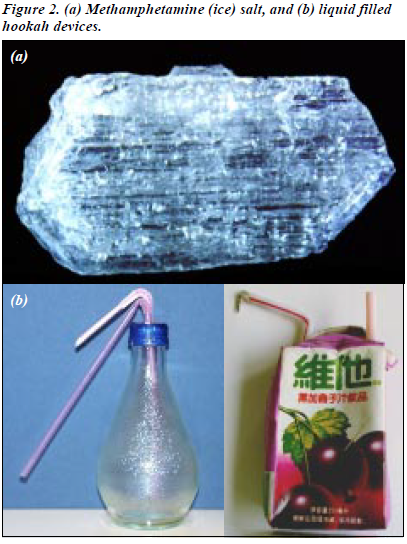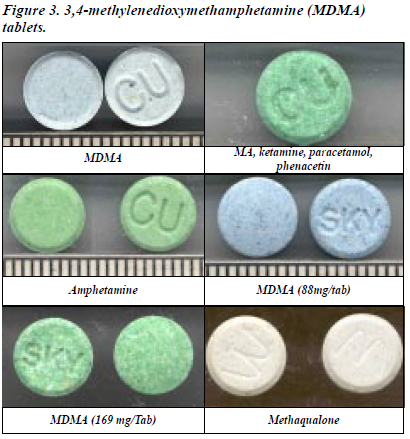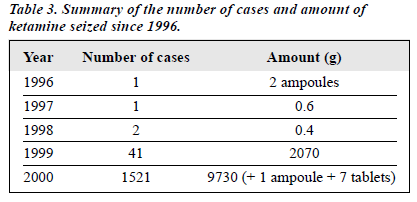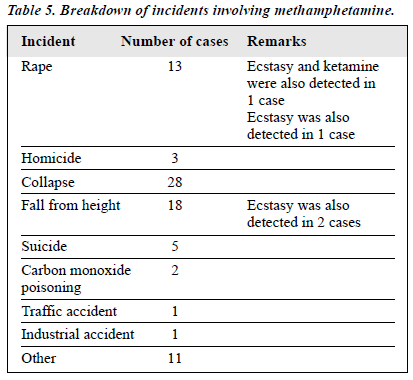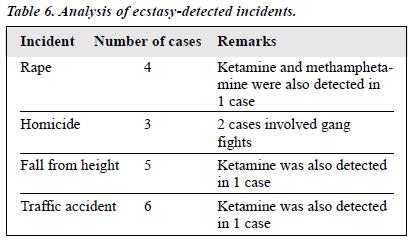Hong Kong J Psychiatry 2002;12(2):13-19
REVIEW ARTICLE
SC Leung
SC Leung, Assistant Government Chemist, Forensic Science Division, Government Laboratory, 7/F Ho Min Tin Government Offices,
88 Chung Hau Street, Ho Man Tin, Kowloon, Hong Kong
Submitted: 27 December 2001; Accepted: 07 March 2002
Abstract
Using abused drugs is an expensive behaviour. Apart from causing health hazards to the users concerned, the associated physiological and psychological effects manifested when taking the drug(s) often induce abnormal behaviour, posing a threat to other people, damaging the abuser’s financial situation, and jeopardising his or her social status. The government’s efforts to steer the public, especially young people, away from abusing drugs have unfortunately been undermined by misleading information about the commonly abused drugs: a notable example being ‘taking Ecstasy can help you keep slim’! Those unfounded myths are due to misunderstanding or lack of knowledge on the part of the drug users. In this paper, facts about certain commonly abused drugs and substances are discussed and myths that may have prompted curious individuals to experiment with them are also introduced.
Keywords: Drug abuse, Psychoactive substance, Substance abuse
Introduction
Drug abuse is a universal problem, occurring in virtually all nations of the world. Over the years, the Hong Kong Government has devoted considerable resources to dis- seminate anti-drug messages and to educate the public on the harmful effects of drugs, with some positive results. The Dangerous Drugs Ordinance is periodically reviewed and revised to include new substances under its control, while law enforcement departments are doing all they can to detect and investigate drug trafficking and manu- facturing. Yet the problem of drug abuse can hardly be eliminated.
Whilst heroin and cannabis have been, and still are, amongst the most popular illegal ‘recreational’ drugs in Hong Kong, a variety of new substances have emerged, formulating new trends of abuse. Following the craze in Western countries, rave parties have become popular amongst young people in Hong Kong in recent years. Origi- nally developed underground, the ‘rave culture’ has only been around in Hong Kong for a few years but has gained increasing popularity.
When such festivals as Halloween and Christmas are drawing near, it would not be difficult to find in magazines advertisements displaying and promoting the so-called ‘rave party look’ which seems to aim at stimulating vanity and luring young people’s romantic imaginations. ‘Party drug’ is a general term representing a wide variety of drugs used by young adults at rave parties. Most, if not all of these are controlled psychotropic substances. Some of these are illicit while others are pharmaceutical preparations. Since they are usually formulated as small tablets, capsules, or powder, they can be easily concealed and conveniently taken, for example by oral ingestion or nasal inhalation. It is no secret that dangerous psychotropic substances are consumed by some participants at rave parties. However, in spite of the generic name, which is somewhat misleading, the consumption of the so-called party drugs is by no means limited to raves. Increasingly, the problem of psychotropic drug abuse has expanded and become a community and media concern.
Reasons for Drug Use
Abusing drugs is an expensive behaviour — in 2000, the average retail price of heroin was approximately HK$376 per gram, while that of the so-called ‘Shake Head’ pills was HK$215 per tablet.1 Apart from being a health hazard to the user, the associated physiological and psychological effects manifested after taking the drug(s) often induce abnormal behaviour, posing a threat to other people, damaging the abuser’s finances, and jeopardising his or her social status. It is known that triads have been present at a number of rave parties, and criminal activities such as selling drugs at the venue, bringing weapons into the venue, and sex crimes have become major concerns.
Despite efforts to contain the problem, to educate the citizens of Hong Kong about the dangers of drug abuse, and provision of facilities to rehabilitate drug addicts, the problem of drug abuse in Hong Kong remains. Sources of misleading information about the commonly abused drugs conveyed through various channels have undermined efforts to steer the public from abusing drugs. A notable example being ‘taking ecstasy can help you keep slim’! As shown in Figure 1, statistics of the Central Registry of Drug Abuse indicate that, in 2000, the reasons for current drug use for reporting individuals in descending order are:
- peer influence/to identify with peers
- to avoid discomfort of its absence
- curiosity
- to seek euphoria or sensory satisfaction
- relief of boredom/depression/anxiety
- for self-medication
- under the influence of a partner.
It may be interpreted that the reasons of “to identify with peers” and “under the influence of a partner” stem from a desire to be recognised, and/or an inclination to associate and socialise with people. However, the physiological and psychological effects produced after taking illegal drugs are often opposite to the original intentions. On the other hand, the reasons of “to seek euphoria or sensory satisfaction”, “relief of boredom/depression/anxiety”, and “for self- medication” seem to be related to a yearn for peace of mind and happiness, and/or a drive towards a better physical or mental condition. Most of these are mythical beliefs! For example, the use of psychoactive substances is popularly believed to loosen sexual inhibitions and contribute to in- creased sexual activity. It is recognised that the connections between alcohol, drugs, and sexual function are complex. Alcohol and drugs can affect sexual function by disrupting or changing levels of neurotransmitters (especially serotonin, norepinephrine, and dopamine), by directly or indirectly affecting the release of various hormones associated with sexual arousal, or by directly affecting blood flow or other physiological mechanisms in the sexual organs.2 Peugh and Belenko have reviewed the available research on sexual function and drugs and concluded that most drugs often have deleterious acute and chronic effects on normal sexual functioning.3 These authors opined that, although a new user of some illicit drugs may experience sexual pleasure or facilitation connected to their substance use, with higher doses and long-term use, these drugs could impair sexual response, reduce sexual desire, and contribute to sexual dysfunction.
Statistics and Trends
Since the danger of heroin should be well understood, this article will focus on other psychotropic drugs of abuse. With the Hong Kong Police Force and the Customs and Excise Department as major clients, the Controlled Drugs Sections of the Government Laboratory are responsible for the identification and analysis of substances controlled under the Dangerous Drugs Ordinance, the Pharmacy and Poisons Ordinance, and the Control of Chemicals Ordinance. The analytical results have strikingly demonstrated that in the ‘business’ of clandestine drug manufacture, there is no quality control. The compositions and dosages can vary considerably: tablets with the same logo may differ in their compositions, while those with the same logo and com- position may differ in their dosages. Statistical figures of illegal drugs encountered by the Controlled Drugs Sections of the Forensic Science Division are provided in the follow- ing text in the chronological sequence of appearance of the drugs.
Methamphetamine
Methamphetamine (ice; MA) is a potent, dependence-forming, central nervous system stimulant that has no legal use in Hong Kong. The MA that is abused locally is almost en- tirely in the form of the hydrochloride salt with high purity (>95%), and appears as grain-sized, colourless, slightly sticky crystals (hence the street name ‘ice’; Figure 2a).
Normally, there are no adulterants added to MA but, on rare occasions, samples adulterated with lactose have been encountered. The crystals may also be ground and made into tablets, and sold under the guise of ecstasy. MA is usu- ally carried in plastic bags or aluminium foil packets; a 1 g plastic bag of MA is called a ‘stroke’. It is usually taken by heating and vaporising the crystals on a strip of aluminium foil, sucking the smoke through a liquid-filled hookah device to cool it off before it enters the body (Figure 2b). It can also be nasally inhaled, injected, or orally ingested.
The first seizure of MA can be traced back to 1976 when this substance was first controlled as a dangerous drug. Statistical figures of seizures of MA during the past 10 years are given in Table 1. It can be seen that the ‘supply’ of MA since 1991 has been stable and is maintained at a high level. Since1996, MA tablets started to appear in the street, probably being sold under the guise of ecstasy, which rapidly gained importance in the same year.
MA is neurotoxic, causing significant reductions in dopamine transporters. Use of MA results in serious health consequences, including memory loss, aggression, violence, psychotic behaviour, and potential cardiac and neurological damage. MA abusers typically display signs of agitation, excited speech, decreased appetite, and increased physical activity levels.
Ecstasy
Ecstasy was originally referred to by its chemical name 3, 4-methylenedioxymethamphetamine (MDMA)and is a member of a chemical group called the phenethylamines. The first seizure of ecstasy occurred in 1993, since when an escalating trend of abuse developed (Table 2). Today MDMA is the most commonly abused psychotropic substance in Hong Kong. Since 1996, the problem of ecstasy abuse has reached an alarming level.
Ecstasy usually appears in the form of round tablets of various colours and embossed with logos ranging from letters to geometrical shapes. These tablets usually weigh 0.3 to 0.4 g and contain an average of 0.1 to 0.15 g of MDMA per tablet. However, the amount of MDMA present in the tablets can range from 0.05 to 0.27g. Nowadays the contents of these tablets are no longer purely MDMA, but are adulterated by various different substances. Tablets of the same ‘brand’ often vary in respect of:
- the chemical nature of the active ingredient(s)
- the amount of the active ingredient(s)
- the composition of the mixtures of substances.
Some tablets contain no MDMA at all but are substi- tuted with something else altogether. These substitutes may well be more dependence forming (such as MA), prone to induce overdose (such as methaqualone or mandrax at grossly elevated dosages), or have properties seemingly antagonistic to those of MDMA (such as ketamine). These variants and mixtures obviously pose serious risks to the uninformed user. Examples of a number of ‘ecstasy’ tablets are given in Figure 3.
Ketamine
Ketamine is a fast-acting general anaesthetic commercially sold as ketalar and ketaset. This drug has sedative-hypnotic, analgesic, and hallucinogenic properties and is mainly used by vets for farm animals, although it also has some human medical applications. Ketamine usually comes as a liquid in its pharmaceutical form but it is available in the street as a white powder or pills with the names ‘K’, ‘K仔’ and ‘茄’.
During the past 2 years, rising trends of abuse of ketamine have been observed, causing such concern in the local com- munity that the drug has been placed in the Dangerous Drugs Ordinance. In 1999, the amount seized rose sharply in terms of both weight and case numbers. Table 3 summarises the cases and the amount of ketamine seized since 1996.
In Hong Kong, the majority of seizures consist of small paper packets of the powdery form of ketamine, weighing approximately 300 mg (Figure 4a). Most samples contain the pure drug but, since 2001, ketamine has been adulterated by various substances, including caffeine and paracetamol. It may also be present in ecstasy and MA tablets. Ketamine is commonly abused by nasally inhaling (‘snorting’) the powder — an example of a device used for this method is snorting the device shown in Figure 4b. Other methods of consumption include oral ingestion, rectal administration, and inhalation of the vapour. It is rarely consumed by either intramuscular or intravenous injection.
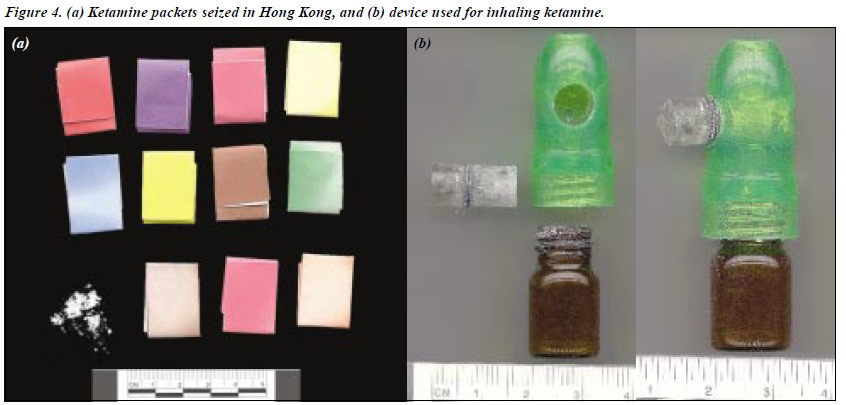
Emergence of New Drugs
Recently, a number of new drugs have appeared in the street, namely ‘Fing 霸’ and ‘Give Me Five’ (‘五仔’, or ‘黄戒 ’). The former contains LSD (lysergic acid diethylamide), a powerful hallucinogen, while the latter is suspected to contain nimetazepam, an unregistered tranquilliser. Both of these have a high potential of becoming popular party drugs.
Fing 霸
Rarely encountered in Hong Kong, LSD was previously found in the form of tiny pieces of blotting paper on which the drug was absorbed (Figure 5). However, so-called ‘Fing 霸’ consists of rounded, dark coloured pills of appro- ximately 2 mm in diameter, weighing 5 to 7 mg. The weight of LSD per pill varies from 20 to 70 mg, with the rest being mainly starch (Figure 6).

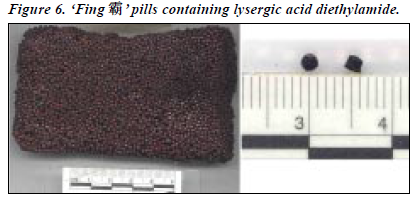
As shown in Table 4, the number of LSD blotter papers examined by the Government Laboratory between 1996 and 1999 was minimal compared with more than 27000 pills of LSD-containing ‘Fing 霸’ examined in 2000.
LSD is a powerful hallucinogen and is taken by mouth. Typically, an LSD user feels the effects of the drug 30 to 90 minutes after taking it. It induces abnormalities in sensory perceptions with unpredictable effects depending on the amount taken, the surroundings in which the drug is used, and the user’s personality, mood, and expectations.
The physical effects include dilated pupils, increased body temperature, increased heart rate and blood pressure, sweating, loss of appetite, sleeplessness, dry mouth, and tremors. LSD users report numbness, weakness, or trembling, and nausea is common. There are 2 long-term disorders that are associated with LSD, namely persistent psychosis and perception disorder (which used to be called ‘flashbacks’).
Give Me Five
A clear trend of abuse of nimetazepam (believed to have street names of ‘Give Me Five’, ‘五仔’, or ‘黄戒 ’) has not been observed. Three isolated cases involving nimetazepam were encountered in 1993 (1570 tablets), 1997 (20 tablets), and 1999 (1 tablet). However, last year, there were 75 cases and 529 tablets were seized. The latest statistical figures are worrying as they indicate that species of new drugs are emerging to supplement the more frequently used drugs (Figure 7).

Gamma Hydroxybutyrate
Gamma hydroxybutyrate (GHB) has street names of
‘grievous bodily harm’, and ‘liquid ecstasy’. GHB is pro- duced as clear liquid, white powder, tablet, and capsule forms. GHB is a central nervous system depressant that can relax or sedate the body. At higher doses, it can slow breathing and heart rate to dangerous levels. GHB’s intoxi- cating effects begin 10 to 20 minutes after the drug is taken. The effects typically last for up to 4 hours, depending on the dosage. At lower doses, GHB can relieve anxiety and produce relaxation. However, as the dose increases, the sedative effects may result in sleep and eventual coma or death.
GHB is usually abused either for its intoxicating/ sedative/euphoriant properties or for its growth hormone- releasing effects, which can build muscles. Both GHB and its precursors, gamma-butyrolactone (GBL) and 1,4-butanediol are found in a number of dietary supplements available in health food stores and gymnasiums to induce sleep, build muscles, and enhance sexual performance.
Overdose of GHB can occur quickly, and the signs are similar to those of other sedatives — drowsiness, nausea, vomiting, headache, loss of consciousness, loss of reflexes, impaired breathing, and ultimately death. GHB is cleared from the body relatively quickly, so it is sometimes diffi- cult to detect in emergency rooms and other treatment facilities. Overseas, GHB has been increasingly involved in poisonings, overdoses, ‘date rapes’, and fatalities.
Until now, the Forensic Toxicology Sections of the Government Laboratory have encountered only 1 case of sus- picious death in which GHB was detected. The concentration of GHB in the deceased’s blood was 100 mg/mL — a level insufficient to have caused death. Whilst GHB does not appear to have presented a problem locally, it may possibly emerge in the future, as a popular drug of abuse in Hong Kong following the trend in other advanced countries.
Toxicology Cases in Which Abused Drugs were Detected
Psychotropic drugs are perilous, not only because of the infliction of chronic damage and the possibility of overdose, but also because of their psychological, stimulatory, or hallucinogenic effects that influence the users. These latter effects produce such abnormalities as an impairment of judgement that could well be equally, if not more, danger- ous than the corresponding physiological hazards of the drugs. Since 1998, there have been 82 incidents involving MA. A breakdown of these incidents is shown in Table 5.
As well as being a toxic, addictive stimulant, MA can induce suicidal traits on the part of the abuser. Thus, apart from those confirmed cases of suicide (5), it is conceivable that a portion of those deaths caused by ‘fall from height’, ‘carbon monoxide poisoning’, and even the traffic and industrial accidents may well have originated from suicidal tendencies induced upon the deceased persons by the abuse of MA.
Since 1999, there have been 18 incidents involving ecstasy. An analysis of the ecstasy-detected incidents is shown in Table 6.
It is interesting to note that of the homicide cases in which ecstasy was found in the body fluid of the deceased, 2 involved gang fights. The deceased persons had probably tried to make use of the stimulating effects of ecstasy to sustain vigour and to promote fearlessness and aggression during the fight. The fact that they did not survive only demonstrates that ecstasy, which had probably cost them their lives, could not provide them with ‘an overwhelming feeling of joy or rapture’. Of the 4 rape cases, the suspect was found to have taken ecstasy in 1 case, the victim in another case was forced to take the drug, whilst in the remaining cases, the victims had taken ecstasy. In the past 2 years there have been 6 incidents involving ketamine. A summary of these incidents is shown in Table 7.
It interesting to find that there was only 1 rape case in which the offender was found to have taken ketamine (to- gether with MDMA and MA), while those involving MA and MDMA (13 and 4 incidents, respectively) were much larger in number. This is not difficult to understand. Ketamine is a fast-acting anaesthetic that eliminates all pain and temporarily paralyses the body — in higher doses, it causes unconsciousness. Even taken at less than anaesthetic levels, routine thinking is blocked, the senses are numbed and the memory dulled, and the drug user is physically in- capacitated. Therefore, in most cases, apart from experien- cing unreal reactions, it would not be possible for the drug user to effectively perform any social activities, let alone an aggressive sexual act.
Conclusion
No drug of abuse is benign. Recent research indicates that long-term abuse of MDMA causes damage to those parts of the brain critical to thought and memory, producing chronic disorders that range from memory loss to motor disturb- ances. One special feature of street drugs is that when they are manufactured, quality control is not a priority. Tablets of the same ‘brand’ often vary tremendously in terms of the gross weight, the dosages, and the nature and composition the ingredient(s). Uncertainties about the drug source, active ingredients, chemicals used in manufacture, and possible contaminants make it difficult to determine the toxicity, consequences, and symptoms that may be expected. In addition, since most street drugs produce sedative and/or hallucinogenic effects, are colourless, tasteless, odourless, and easily dissolved in water, they can unnoticeably be added to beverages by individuals who want to intoxicate or sedate others. These substances, whether taken voluntarily or by deceit, leave women vulnerable to sexual assault and rape. As the variety and potency of these drugs increase, the problem of abuse grows.
The government’s efforts to steer the public, especially young people, from abusing drugs have unfortunately been undermined by sources of misleading information about the commonly abused drugs. Those unfounded myths are due to misunderstanding or lack of knowledge on the part of the drug users.
As protectors of public health and safety, governmental bodies, notably the Narcotics Division and law enforcement agencies, in collaboration with such organisations as ACAN (Action Committee Against Narcotics), are taking effective measures to help solve the problem. In order to present current information and photographs of the prevailing drugs of abuse in Hong Kong, the Forensic Science Division of the Government Laboratory has produced a bulletin titled Selected Abused Drugs in Hong Kong. The Narcotics Division is coordinating the distribution of the bulletin to relevant law enforcement departments and frontline workers in the ‘beat-drug’ campaign such as clinicians and social workers. It is hoped that the facts presented in this publication could be conveyed to drug users so that the myths they possess could be nullified.
Acknowledgement
The author would like to record here his gratitude to Dr DG Clarke, Government Chemist, for approval to publish this paper and for proof reading the draft.
References
- Hong Kong Narcotics Reports 2001. Hong Kong: Narcotics Division, Security Bureau and Action Committee Against Narcotics; 2001.
- Buffum J. Pharmacosexology: the effects of drugs on sexual function: a review. J Psychoactive Drugs 1982;14:5-44.
- Peugh J, Belenko S. Alcohol, drugs and sexual function: a review. J Psychoactive Drugs 2001;33:223-232.

